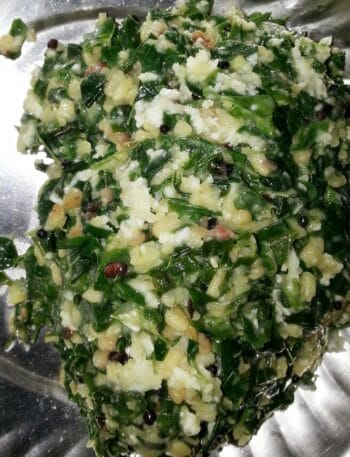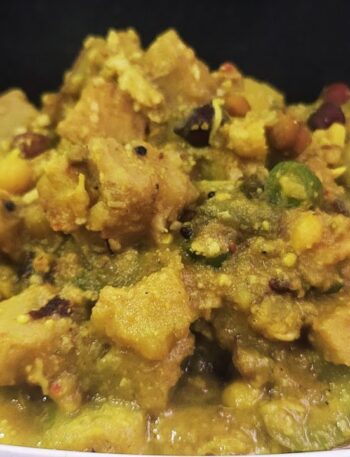Origin and Cultural Significance—
Besara is a dish that embodies the characteristics of a specific culture, region, and tradition. It is one of the ancient vegetarian preparations served as part of the Mahaprasad at the Jagannath Temple in Puri. In ancient times, mustard seeds were one of the key crops in Odisha, and their pungent, nutty flavour became a cornerstone of many traditional recipes. Odia households cook wholesome dishes with locally available vegetables, mustard seeds, and a few spices.
Historically, “Besara” is a part of “Chappan Bhog” (56 food offerings) offered daily to Lord Jagannath at the Jagannath Temple, Puri. It holds a special place as a simple, nourishing, and flavourful vegetable curry prepared with mustard-based curry crafted without onion and garlic, adhering to the Sattvik principles of temple cuisine. It is believed to be the largest open-air temple kitchen in the world, known as “Ananda Bazaar.”
A Dish Steeped in Tradition & Community Bonding—
In Odisha, food is a celebration of heritage, faith, and togetherness. Besara, in particular, reflects the deep-rooted values of simplicity, purity, and communal sharing.
🌿 A sacred temple offering: Traditionally prepared in the Jagannath Temple’s Ananda Bazaar, Besara is part of the sacred Chappan Bhog and symbolises purity through its sattvik (onion-garlic free) preparation.
🌾 A reflection of seasonal, local produce: Besara celebrates Odisha’s agricultural abundance by using fresh, locally grown vegetables like pumpkin, raw banana, brinjal, and drumsticks, paired with a mustard-cumin paste.
🏡 A household classic for auspicious occasions: Beyond temple rituals, Besara is often cooked in Odia homes during religious festivals, family pujas, and community feasts, fostering a sense of togetherness and shared tradition.
✨ A culinary bond across social boundaries: At the Jagannath Temple, Mahaprasad, including Besara, is consumed collectively by people of all castes and backgrounds — a rare practice symbolising equality and spiritual unity.
🥣 How to Make Besara at Home—
Traditionally, Besara is prepared over a wood-fired earthen stove in the temple, lending it a unique earthy flavour, but at home you may use a heavy-bottomed pan, or clay pot or a kadhai.
Other equipment required is:
✔️Mixing bowl
✔️Stone grinder/mixer grinder (for mustard paste)
✔️spatula
✔️Knife
✔️Measuring Spoons
✔️Serving Bowl
Ingredients: (For 3-4 servings)
🟡 2 tbsp mustard seeds (sorisha)
🟠 1 tsp cumin seeds (jeera)
🌶 2–3 dry red chillies
🟡 1 tsp turmeric powder
🧂 Salt, to taste
🥄 2 tbsp mustard oil
🌸 ½ tsp Panch Phutana (optional, five-spice mix)
Seasonal vegetables (about 2 cups, chopped medium-sized):
🎃 Pumpkin (boitalu)
🍌 Raw banana (kancha kadali)
🍆 Brinjal (baigana)
🌿 Drumsticks (sajana chhuin)
🍠 Sweet potato (mitha aloo)
🌿 Taro root/Arbi (saru)
🥔 Potato (aloo)
🌸 Optional:
🍯 A pinch of jaggery (for mild sweetness)
🫚 A small piece of ginger (optional, traditionally very mildly used)
Step-by-Step Cooking Instructions—
Get the ingredients ready:
- Soak Mustard seeds, cumin seeds and dry chillies in water for about 20 minutes and grind them into a smooth paste.
Chop the Vegetables:
- Wash, peel and chop the vegetables into medium-sized chunks. You can mix and match seasonal vegetables, too.
Temper the Oil:
- Take a pan or kadhai, heat some oil and add some mustard seeds, till they reach their smoking point.
- Lower the flame and add panch phutana(five-spice blend), let it splutter.
Saute the vegetables:
- Add the chopped vegetables to the pan and toss them for a time.
- Add a pinch of turmeric and salt, and saute the vegetables for 2-3 minutes.
Add Mustard paste & cook the vegetables:
- Pour the prepared mustard paste into the pan.
- Add vegetables and some water for the desired consistency. Cover and cook on a low flame until the vegetables soften and enhance the mustard flavour.
- Stir occasionally, add a small piece of jaggery to balance flavours (Your choice).
Final touch and Serving:
- Drizzle a teaspoon of hot mustard oil on top for an enhanced aroma. Transfer the Besara to a serving bowl and serve fresh from the pot, with steamed rice, Kanika or Dalma.
Best Ways to Enjoy Besara—
🍽️Traditional Pairings:
✔️Steamed Rice (Arua Chawla)- The neutral flavour of plain steamed rice balances the sharp, pungent mustard gravy of Besara, making it the most traditional and essential pairing.
✔️Kanika (Sweet Ghee rice)- A mildly sweet and aromatic rice preparation made with ghee, sugar, and dry fruits. It beautifully offsets the boldness of the mustard paste in Besara
✔️Dalma (Lentils with vegetables)- A comforting lentil-based dish cooked with vegetables, tempered with cumin and ghee. Its mild, earthy taste pairs wonderfully with the tangy, spicy Besara.
✔️ Pakhala (Fermented rice water dish)- Especially popular in summer, this cool, probiotic-rich dish complements the heat of mustard-based curries and balances digestion.
✔️ Saga Bhaja (Fried leafy greens)- Crisp, lightly spiced stir-fried greens (like amaranth or spinach) serve as a perfect side for Besara, adding texture and nutritional value to the meal.
✔️Khatta (Chutney or relish)-Tamarind or mango-based chutneys bring a sweet-sour note that balances Besara’s pungency and adds variety to the plate.
🍹 Beverage Pairings:
✔️ Chilled coconut water (Dabu pani)- A natural coolant that refreshes the palate and balances the mustard’s heat.
✔️Chaas (Odia style spiced buttermilk)- Lightly spiced with roasted cumin and salt, this helps digest mustard-rich curries and complements the meal beautifully.
✔️Lemon Water (Gholta pani)- Simple lemon water with a pinch of black salt and roasted cumin can be a refreshing drink alongside this meal. You may also add mint leaves for a refreshing touch.
🍮 Desserts for a Sweet Ending:
✔️ Chhena Poda– A beloved Odia dessert, this baked cottage cheese delicacy carries subtle notes of cardamom and a rich caramelised crust. Its mild sweetness offers a perfect contrast to the bold flavours of the curry.
✔️Kheer (Rice Pudding)- A creamy, cardamom-infused dessert made from rice and milk, perfect for mellowing down a rich, spicy meal.
✔️Khaja- A flaky, layered, deep-fried sweet soaked in a light sugar syrup. Served as Mahaprasad at Puri Jagannath Temple, this makes a lovely end to a Besara meal.
✔️Rasabali- Soft, fried cheese patties soaked in thickened sweetened milk, originating from Odisha’s Kendrapara — another temple-favourite dessert.
✔️Pitha (Odia Rice Cakes) – Lightly sweet steamed or fried rice cakes (like Kakara or Enduri Pitha) served during festive meals alongside savoury dishes like Besara.
Storage & Leftover Tips—
- Cool the dish and refrigerate it in an airtight container to maintain freshness and prevent condensation inside the container. It can be stored for 2-3 days.
- Use a freezer-safe airtight container or ziplock bags for storage (Avoid plastic containers).
- While reheating, splash some water to restore the desired consistency and heat it over a low to medium flame.
- Avoid overheating, as mustard paste can become bitter when overcooked— mustard paste tends to turn bitter if overcooked. If using a microwave, heat in short intervals, stirring in between to ensure even heating.
🌿 Pro-Tip:
Do not freeze Besara. Mustard-based gravies tend to separate and lose their aroma when thawed. It is a dish best enjoyed fresh or within 48 hours.
Health Benefits of Besara—
- The mustard seeds and cumin seeds used in Besara are rich in antioxidants like selenium and magnesium, which help to deal with stress and inflammation.
- The combination of fibre from vegetables, like pumpkin and raw banana, along with cumin and fennel seeds, helps in better digestion and prevents constipation. Mustard also has mild digestive properties.
- When heated correctly to the smoking point, mustard oil is rich in monounsaturated fatty acids (MUFAs) and omega-3s, which support heart health by lowering bad cholesterol (LDL Levels) and improving cardiovascular health.
- According to Ayurveda, mustard-based curries like Besara, their pungent and warming qualities, help balance Kapha and Vata doshas. It is particularly recommended in monsoon and early summer seasons to prevent digestive sluggishness.
- As a sattvik (onion-garlic-free) dish, Besara is easy on the stomach, free from heavy spices, and suitable for religious fasting days, festive occasions, and temple rituals.
A Dish That Embodies Odisha’s Culinary Soul—
In Odisha, where food is a heartfelt celebration of faith, nature, and togetherness, Besara remains a soulful reminder of its enduring culinary legacy. From the sacred kitchens of Puri’s Jagannath Temple to the humble hearths of Odia households, this mustard-laced vegetable curry has nourished generations with its simplicity, purity, and deeply rooted traditions.
More than just a recipe, Besara is a story of ancient rituals, sustainable eating, and meals shared without barriers. It embodies the wisdom of seasonal, sattvik cooking and the warmth of communal bonds.
In every spoonful, you’ll taste not just vegetables and spices, but the essence of Odisha’s heritage, where food is much more than sustenance; it’s a living, breathing expression of devotion, culture, and belonging.
If you haven’t tasted Besara yet, you haven’t truly known Odisha.
🌸 Besara Beyond Basics: Classic Odia Recipes to Try
Besara isn’t limited to one version — it’s a versatile, mustard-based curry style found across Odia kitchens, each with its own unique twist. Explore these traditional Odia recipes that carry forward the bold, earthy flavours of Besara:
Poi Besara – Malabar spinach cooked in a tangy mustard paste with seasonal vegetables.
Khatta Besara – A sweet and tangy version of Besara prepared with mustard paste, vegetables, and a hint of jaggery and tamarind.
Chhatu Besara – Tender mushrooms (chhatu) cooked in mustard paste with minimal spices for a rustic, earthy curry.
Machha Besara – A coastal Odia classic where freshwater fish is gently simmered in a pungent mustard-cumin gravy, enriched with mustard oil.
Ouu Besara – Elephant apple (ouu) cooked with mustard paste and jaggery for a unique sweet-tangy flavour.
Sajana Besara – Drumsticks (sajana chhuin) prepared in a pungent mustard gravy, perfect with steamed rice.
(Recipes coming soon — stay tuned!)
👉 Click on the links above to discover more authentic ways to savour Besara’s bold flavours.
✨ And let us know in the comments which one you would love to try first! 😊comments which one you would love to try first! 😊





